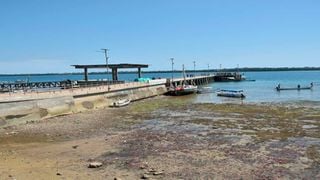
Shimoni Jetty in Kwale County where traders from Kenya, Zanzibar and Pemba operate.
| File | Kevin Odit | Nation Media GroupKwale
Premium
The smugglers’ coast: How illicit trade thrives in Shimoni
As they say on land, the early bird catches the worm, it is true that for a fisherman to get the best catch of the day, he must be up at dawn.
And so, for the dozens of fishers at Kibuyuni in Shimoni, Kwale County, the morning madness is necessary to bring seafood to the dining tables of hundreds of their customers.
But there’s more to just fishing in this part of the Indian Ocean. It’s also a smuggling hub. Usually, contraband goods – such as rice and sugar – from Tanzania land at 3am.
Canoes get the sacks of rice and sugar from the large boats in the ocean to the shores. They are then loaded onto trucks and moved to major urban centres.
Shimoni is among three official border points in South Coast. There are, however, five unmanned entry points; Kibuyuni, Mazaro, Bati, Kiwambale and Mwambale. There’s only one Kenya Revenue Authority checkpoint.
The other points are Vanga and Lungalunga, where there is a One-Stop Border Point. Unscrupulous traders have taken advantage of the weak Lunga Lunga, Vanga and Shimoni borders to smuggle contraband goods. Here, illicit trade thrives.
“Cartels have mastered these points. They bring their people to transport the goods once they land on the shore,” said a source.
This happens at least twice every week. They usually ferry the goods to Ukunda, Kwale and Likoni, where they have a ready market. Sugar and rice are the most common.
Different agencies that are expected to police the entry points on the Kenya-Tanzania border along the Coast have failed.
Last week, KRA officers nabbed 65 bags of powder soap weighing 795kg, which had been imported illegally from Tanzania via Vanga township.
KRA Southern Region Coordinator, Mr Joseph Tanui, said if the soap had reached the local market, the government would have lost Sh96,354 in taxes.
“The government has been losing millions of shillings due to widespread tax evasion by unscrupulous traders. Smuggling benefits a few people but in the long run, affects all of us. It’s important that businesspeople engage in lawful ventures,” he said.
Mr Tanui said smugglers use boats, motorcycles and panya routes to bring the goods into Kenya.
“We will stop these cartels by engaging law enforcement and intelligence agencies. We shall confiscate contraband goods. We shall sensitise border communities about taxation,” he said.
KRA will also work with other agencies to fight smuggling, which exposes honest investors to unfair competition.
Coast Regional Coordinator John Elungata last week ordered a crackdown on illegal trade along the porous borders.
“We need a tougher approach to smuggling. The seizure of contraband goods at border points will send a signal that we are on high alert,” he said in a recent meeting with security agencies in Lunga Lunga.
Mr Elungata urged security officials at Shimoni and Vanga border points to help stem the flow of illegal goods. He said the illicit goods hurt local manufacturers.
He has put boda boda riders who smuggle contraband through panya routes on notice.
Data from the National Crime Research Centre shows that last year, sugar accounted for nearly half of the goods smuggled across Kenya’s porous borders, accounting for 48 per cent of all the incidents, with 789 cases reported in 2019.
Other popular products are alcohol and illicit brews (28 per cent), illegal drugs such as cocaine and heroin (25.2 per cent), cereals (23 per cent), clothes, shoes and handbags (12.8 per cent), charcoal/coal (12 per cent) and wheat and maize flour (11.3 per cent).
Sugar is smuggled mainly through Garissa, Kajiado, Narok, Migori, Mandera, Kwale, Trans Nzoia and Busia.





